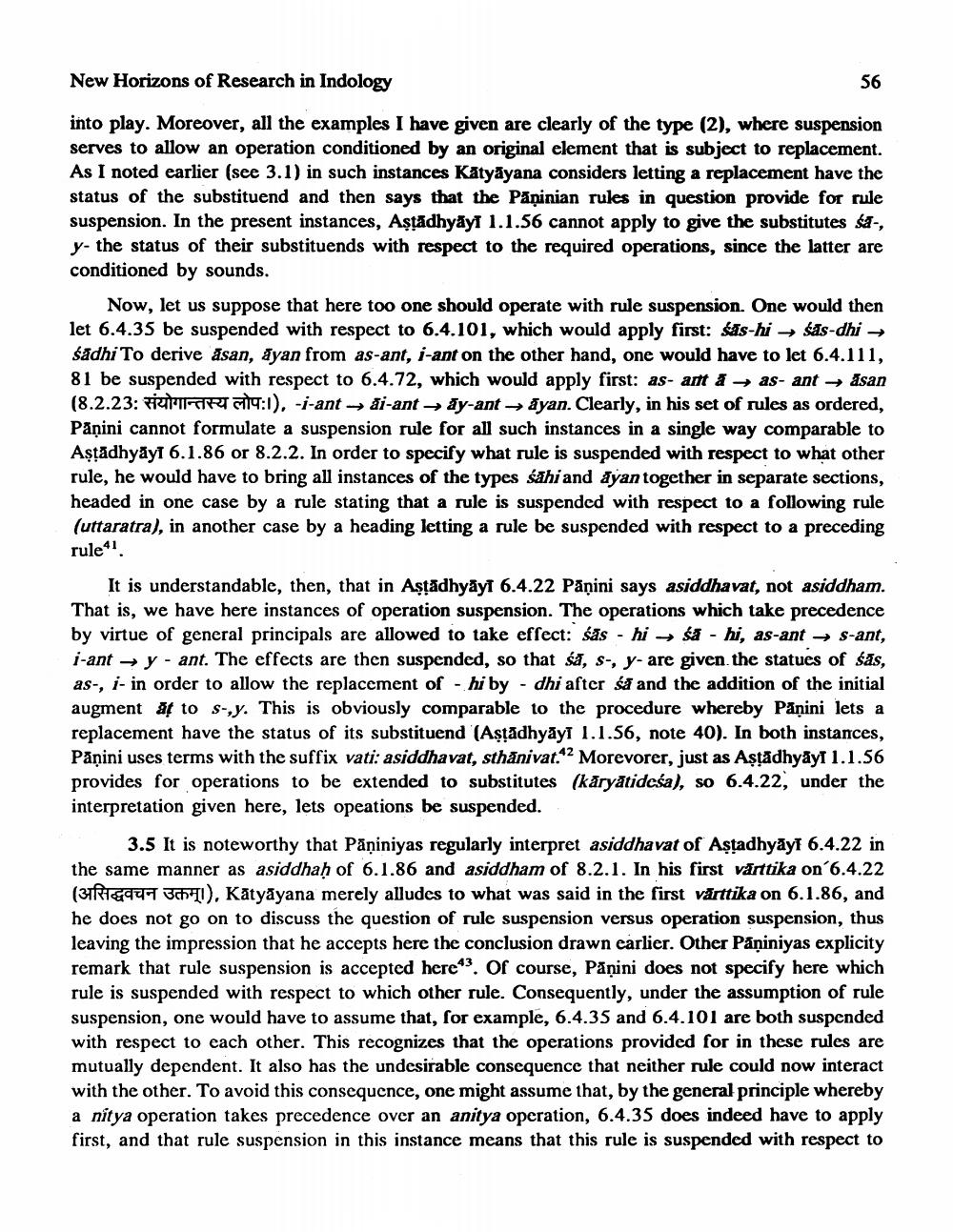________________
New Horizons of Research in Indology
into play. Moreover, all the examples I have given are clearly of the type (2), where suspension serves to allow an operation conditioned by an original element that is subject to replacement. As I noted earlier (see 3.1) in such instances Katyayana considers letting a replacement have the status of the substituend and then says that the Papinian rules in question provide for rule suspension. In the present instances, Aṣṭādhyāyl 1.1.56 cannot apply to give the substitutes -, y- the status of their substituends with respect to the required operations, since the latter are conditioned by sounds.
56
Now, let us suppose that here too one should operate with rule suspension. One would then let 6.4.35 be suspended with respect to 6.4.101, which would apply first: s-his-dhi→ sadhi To derive asan, ayan from as-ant, i-ant on the other hand, one would have to let 6.4.111, 81 be suspended with respect to 6.4.72, which would apply first: as- ant a→ as- ant → äsan (8.2.23: :1), -i-anti-antay-antayan. Clearly, in his set of rules as ordered, Panini cannot formulate a suspension rule for all such instances in a single way comparable to Aṣṭadhyay 6.1.86 or 8.2.2. In order to specify what rule is suspended with respect to what other rule, he would have to bring all instances of the types sahi and ayan together in separate sections, headed in one case by a rule stating that a rule is suspended with respect to a following rule (uttaratra), in another case by a heading letting a rule be suspended with respect to a preceding rule11
It is understandable, then, that in Aṣṭādhyay 6.4.22 Panini says asiddhavat, not asiddham. That is, we have here instances of operation suspension. The operations which take precedence by virtue of general principals are allowed to take effect: śās - hi→ sa - hi, as-ant → s-ant, i-ant → y - ant. The effects are then suspended, so that sa, s-, y- are given the statues of sās, as-, i- in order to allow the replacement of hi by dhi after sa and the addition of the initial augment af to sy. This is obviously comparable to the procedure whereby Panini lets a replacement have the status of its substituend (Aştädhyay 1.1.56, note 40). In both instances, Panini uses terms with the suffix vati: asiddhavat, sthänivat. Morevorer, just as Aṣṭādhyāyl 1.1.56 provides for operations to be extended to substitutes (käryätideśa), so 6.4.22, under the interpretation given here, lets opeations be suspended.
3.5 It is noteworthy that Paniniyas regularly interpret asiddhavat of Aṣṭadhyay 6.4.22 in the same manner as asiddhaḥ of 6.1.86 and asiddham of 8.2.1. In his first värttika on 6.4.22 (зffen 311), Katyayana merely alludes to what was said in the first värttika on 6.1.86, and he does not go on to discuss the question of rule suspension versus operation suspension, thus leaving the impression that he accepts here the conclusion drawn carlier. Other Paniniyas explicity remark that rule suspension is accepted here. Of course, Panini does not specify here which rule is suspended with respect to which other rule. Consequently, under the assumption of rule suspension, one would have to assume that, for example, 6.4.35 and 6.4.101 are both suspended with respect to each other. This recognizes that the operations provided for in these rules are mutually dependent. It also has the undesirable consequence that neither rule could now interact with the other. To avoid this consequence, one might assume that, by the general principle whereby a nitya operation takes precedence over an anitya operation, 6.4.35 does indeed have to apply first, and that rule suspension in this instance means that this rule is suspended with respect to




